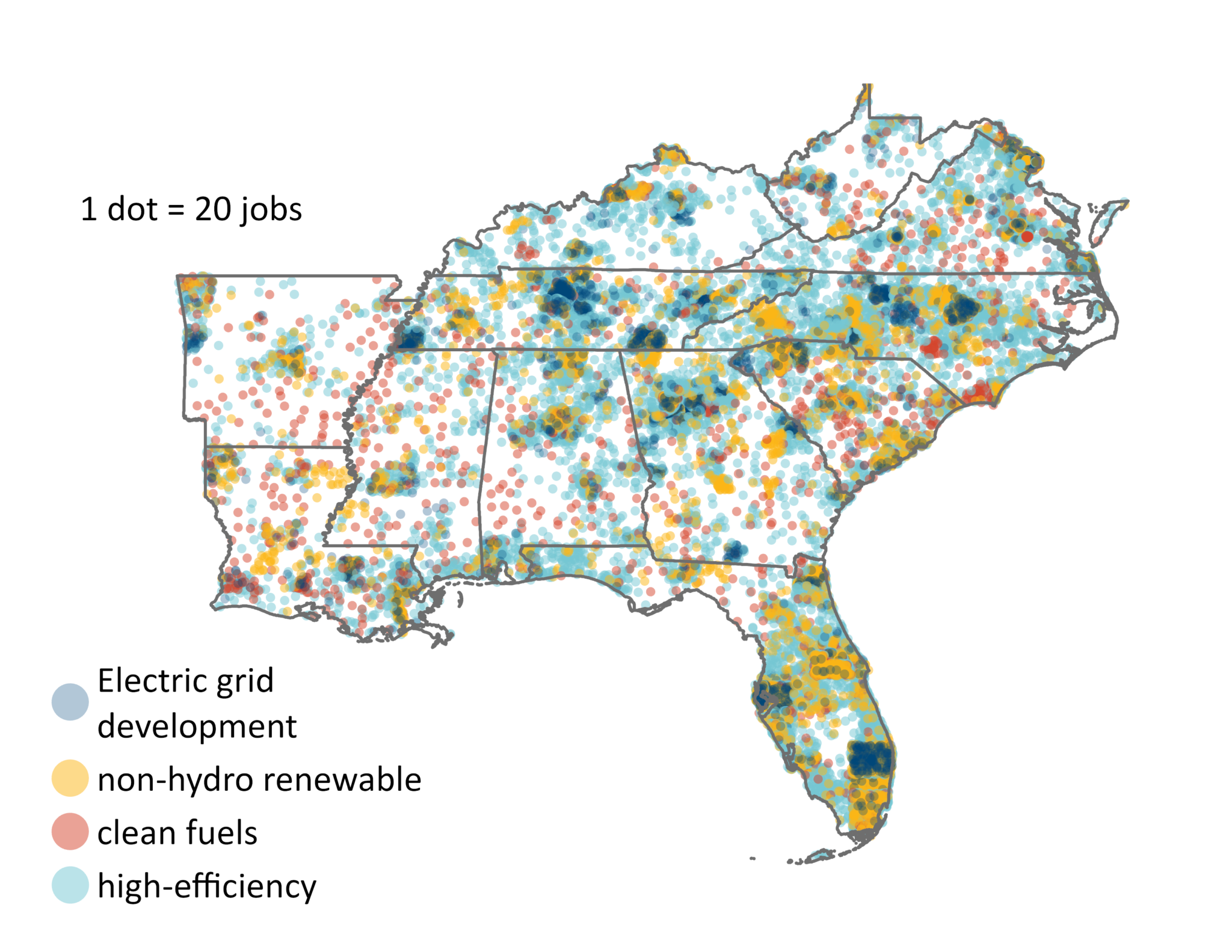Month: November 2024
November Map of the Month
By Amy Lovell
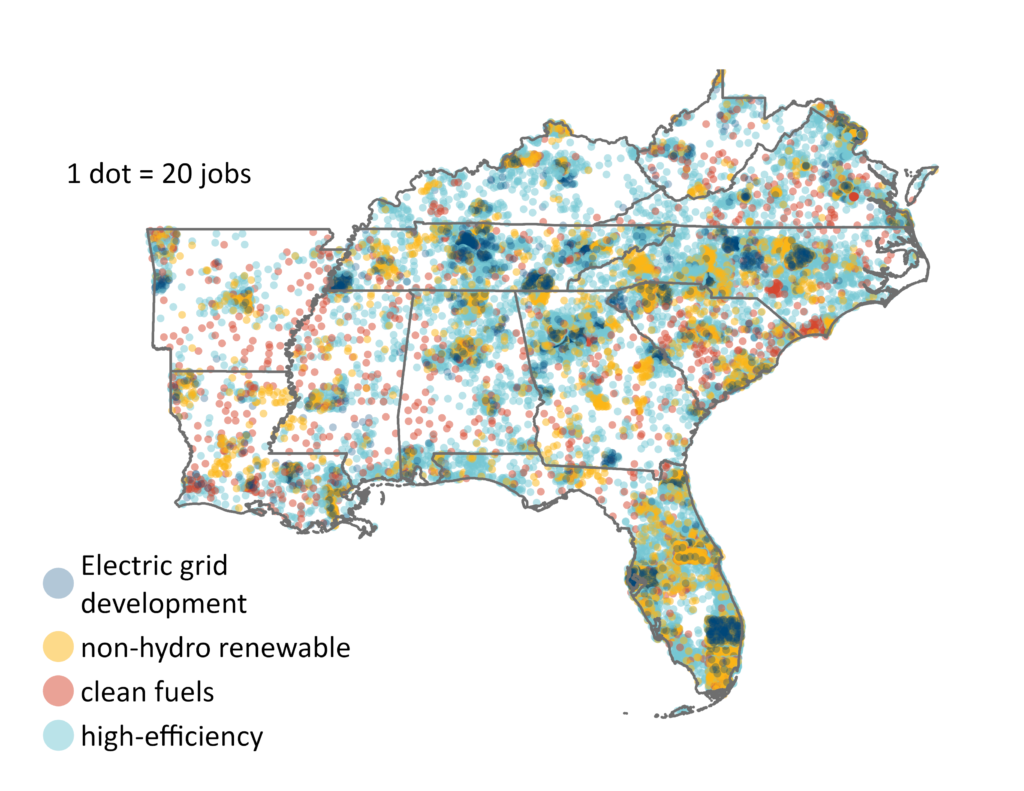
Source: United States Energy & Employment Jobs Report (USEER)
Over the past few years, a “Battery Belt” has emerged in the Southeast, where massive investments in clean energy and cleantech production are reviving the region’s manufacturing economy and creating thousands of new jobs. These jobs have rightly been at the forefront of regional and national economic development efforts and planning for the energy transition. What has been less prominent in these discussions is the region’s already-thriving clean energy workforce, which spans a myriad of job types and virtually all parts of the region.
This month’s map uses data from the United States Energy & Employment Jobs Report (USEER) from 2023 to explore the extent and impact of the clean energy workforce in the Southeast. It illustrates that clean energy is a significant source of jobs in most counties in the region, and calls attention to how diverse these jobs are across sectors and job type.
Clean energy jobs are an increasingly large portion of the energy workforce nationwide and provide 39% of the energy jobs spread across the Southeast. 87% of counties in the Southeast have a workforce of ten or more jobs in clean energy, which exceeds the national average of 83%. The region’s high-efficiency workforce is the largest and most geographically dispersed in the nation: 73% of counties have a workforce in efficient lighting, energy STAR, high-efficiency heating ventilation and air conditioning (HVAC), and advanced materials and insulation.
Of the 1.2 million non-automotive energy jobs in the Southeast, 474,613 jobs (39%) are in the clean energy workforce categories of 1) non-hydro renewable power generation, 2) electric grid modification, 3) high-efficiency or 4) clean fuels. The 340,000 high-efficiency jobs represent the largest fraction (72%) of this workforce. Nationally, 41% of energy jobs are in these clean energy categories, with 64% in high-efficiency jobs. Renewable energy employs fewer workers (40%) in the Southeast than nationwide (54%), but has been experiencing consistent growth, in part due to significant efficiency and clean energy investments in the region.
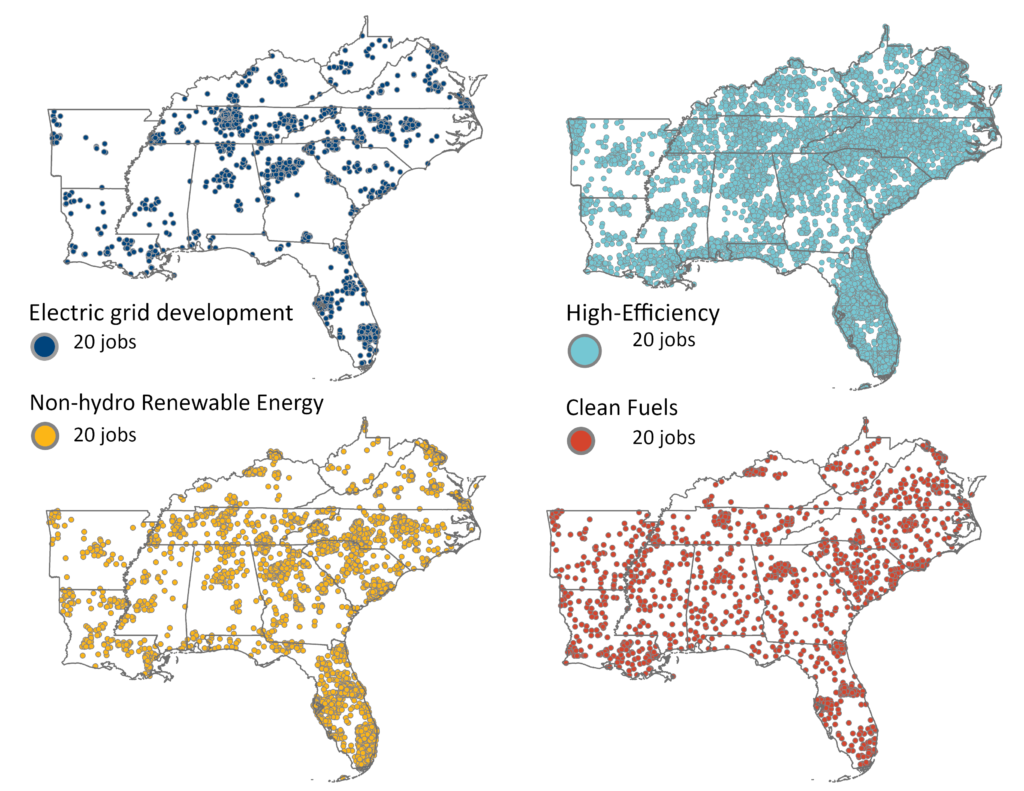

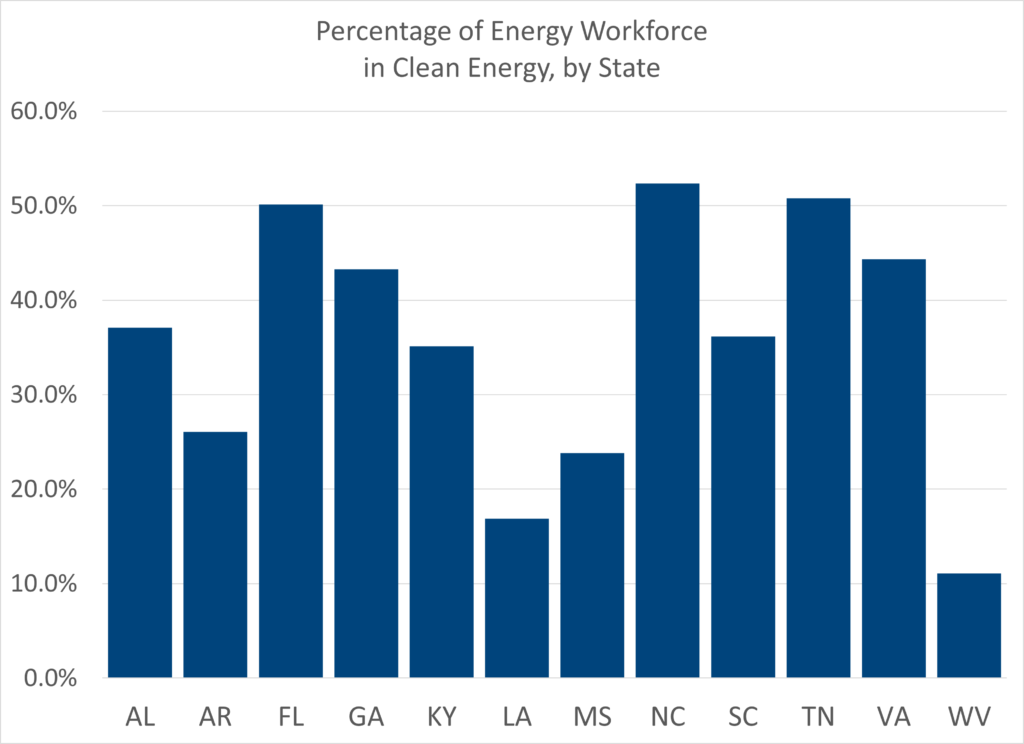
The percentages of the energy workforce in clean energy vary across Southeastern states. Florida, North Carolina, and Tennessee have over half of their energy workforce in clean energy, while Louisiana (17%) and West Virginia (11%) have the lowest fractions. Rural areas and regions with a significant Black, Indigenous, and People of Color (BIPOC) population have the greatest potential for job growth.
In the fuels workforce, petroleum, natural gas and coal comprise the majority (85%) of workers, with clean fuels including woody biomass and corn ethanol making up a combined 15% of the fuel workforce, comparable to the national average. Georgia (32%), North Carolina (41%), South Carolina (49%), and Tennessee (32%) have the highest portions of the fuel workforce in clean fuels.
From 2020-2023, solar and wind energy jobs grew from 35% to 40% of the power generation workforce, with North Carolina and Georgia crossing 50% of workers in renewable power generation. In the same period, the national workforce in renewables only grew from 53% to 54%, so the Southeast is realizing some potential for growth for workers in this area.
Transmission, Distribution, and Storage (TDS) jobs in the Southeast are primarily in traditional TDS, with 11% of this workforce in storage, smart grid, microgrids, and other grid modification work. Tennessee has by far the largest fraction of the TDS workforce in this category, at 26%.
While the emergence of the “Battery Belt” and transformational investments in clean energy manufacturing are key factors shaping the region’s economy growth, the Southeast has a seasoned and thriving clean energy workforce. Though jobs in renewable energy and clean fuels may be more easily recognized as part of the clean energy workforce, it also includes many jobs improving building efficiency and innovating our electric grid. This workforce has been expanding more rapidly than in the rest of the nation, and it provides opportunities for people with a range of skillsets living in virtually any community in the region to participate in the clean energy economy.
Southeast Energy Efficiency Alliance Announces 2024 Summit Award Winners
The Southeast Energy Efficiency Alliance (SEEA) announced the winners of the 3rd Annual Summit Awards today, Thursday, November 21, during the 2024 Southeast Energy Summit. The Summit Awards recognize individuals and organizations forging a more equitable, efficient energy future in the Southeast.
The award winners are as follows:
The Vanguard Award for Innovation in Efficient Energy – Cobb EMC
Cobb EMC’s nomination for the Vanguard Award highlights its groundbreaking microgrid project, completed in September 2022, which integrates innovative technologies like a 1.8 MW solar PV system, a 1 MW/4 MWh battery energy storage system, and a 1 MW renewable natural gas generator. This initiative supports Cobb EMC’s goal of reducing carbon emissions by 75% and expanding its renewable energy portfolio by 2030. The microgrid has produced over 9.3 million kWh of energy, equivalent to avoiding nearly 746,000 gallons of gasoline, while enhancing energy reliability for its members.
Additionally, the EV Smart Charging Pilot encourages off-peak EV charging to lower demand, and community solar projects are being developed to increase accessibility. These efforts not only improve sustainability but also inspire other electric cooperatives in Georgia to adopt similar clean energy initiatives. Cobb EMC’s leadership exemplifies how innovation can drive significant advancements in energy efficiency and equity across the Southeast.
About the Vanguard Award for Innovation in Efficient Energy
At its best, efficient energy is a holistic approach to the generation, distribution and utilization of energy that maximizes social benefit and promotes prosperity. Efficient energy includes programs to optimize energy use in residential and commercial buildings, zero- and low-emission transportation and advanced technology. Innovation in efficient energy is characterized by a new method, technology or idea that has resulted in a net-new advancement in efficient energy. This award recognizes an outstanding organization or program that has championed an innovative approach to efficient energy in the Southeast.
The Luminary Award for Pursuing Energy Equity – Lucky Shoals Community Association, Gwinnett Housing Corporation, and Georgia Hispanic Construction Association
The coalition’s nomination for the Luminary Award is a testament to its unwavering commitment to energy equity in unincorporated Norcross, Georgia. This area, characterized by its diverse and under-resourced population, faces significant energy cost burdens, with over 85% of residents identifying as BIPOC and nearly 25% living in poverty. The coalition, comprising Gwinnett Housing Corporation (GHC), GHCA, local representatives, and SEEA, has effectively harnessed funding and resources to directly address these inequities. Through extensive community engagement, including canvassing all 21,980 households and administering multilingual surveys, they prioritized the voices of residents in shaping energy solutions. Their initiatives have not only provided access to over 50 energy assistance programs and $3 million in HUD-funded repairs but also empowered local contractors through training and scholarships. This holistic approach—rooted in listening, learning, and community involvement—has fostered sustainable change and improved access to energy benefits for thousands in a historically marginalized community. Their work exemplifies the spirit of the Luminary Award by demonstrating that true energy equity is achieved through active community engagement and empowerment.
About the Luminary Award for Pursuing Energy Equity
Energy equity is measured by the presence of an inclusive decision-making process, the equitable distribution of both the costs and advantages of energy use to the entire community, accounting for historic prejudice and inequality and a view of how future generations will be impacted by choices made today. This award celebrates the accomplishments of an outstanding organization or program that has made significant strides in pursuing energy equity by sharing in the benefits and burdens of the energy transition regardless of income, race, ethnicity, gender or geographic location. Benefits of an equitable energy transition include greater access to efficient energy technologies, a more diverse workforce, healthier buildings and people, more resilient buildings and a more vibrant economy for all.
The Peak Award for Excellence in Leadership – Drew Frye, TVA
Drew Frye’s nomination for The Peak Award for Excellence in Leadership showcases his vital role in advancing energy efficiency and clean energy in the Southeast. As a key driver of TVA’s Fast Charge Network, he has established the Tennessee Valley’s largest open-access electric vehicle fast charging network, adding over 100 fast chargers and facilitating more than 25,000 charging sessions in just two years. This initiative enhances EV infrastructure, promotes economic growth, and improves air quality across seven southeast states.
Drew’s focus on equity ensures that fast chargers are accessible in both urban and underserved rural areas, empowering all residents to adopt electric vehicles. His commitment to education is evident in resources like the EV Buyer’s Guide and TVA’s Driving EVolution Blog Series, which helps individuals understand the benefits of electric transportation and clean energy technologies. Through his innovative leadership and collaborative spirit, Drew inspires others to engage in the clean energy sector, making him a deserving recipient of this award and exemplifying effective leadership that enhances quality of life in the Southeast.
About the Peak Award for Excellence in Leadership
Leadership is a multifaceted quality that creates a clarity of mission, an environment that encourages innovation at all levels of an organization, and empowers others within the organization and in the community. This award is given to an exceptional individual who demonstrates leadership in the efficient energy sector, considering greater energy efficiency, low- and zero-emission transportation, equitable energy benefits and burdens, and the advancement of the community at large.
Room to Breathe: Lessons from Atlanta’s First Healthy Housing Program
By Laura Diaz-Villaquiran
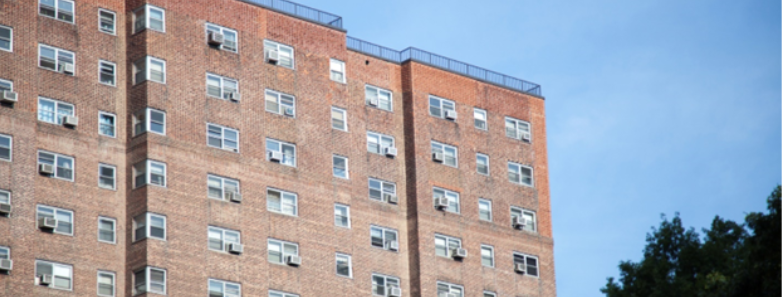
SEEA is excited to share the results of the Room to Breathe pilot program that we led alongside the Atlanta Volunteer Lawyers Foundation (AVLF) and SK Collaborative. Room to Breathe, which ran from 2021 to 2023, was the first healthy housing program in the City of Atlanta to provide low-income renters with efficiency and healthy housing assessments. By helping renters access energy and health testing for their homes as well as legal aid services, this program facilitated health and safety upgrades and supported those at risk of eviction.
This program underscored the deeply interconnected nature of energy insecurity, housing insecurity, housing quality, health, and occupant safety. Diana Hernández has introduced the concept of energy insecurity, a framework that highlights how unaffordable energy costs and the inability to maintain essential energy services can force individuals to make difficult choices, such as sacrificing food and medicine.1 In this program, participating households were energy insecure, and tended to live in energy-inefficient homes, often under the looming threat of eviction—conditions strongly associated with negative health outcomes, including respiratory problems.
Recognizing these interconnected challenges, our pilot program was designed to address both housing quality and energy efficiency issues, with a focus on improving the affordability, health, and sustainability of housing. We believe this is a promising model for supporting low-income renters who face steep barriers to accessing assistance for home repairs and energy efficiency upgrades.
Program Model

Figure 1. Room to Breathe program model. This model can be replicated without the large outlays of start-up capital required for most energy efficiency or healthy housing programs.
Renters who had reached out to AVLF for legal assistance were pre-screened through an over-the-phone questionnaire that evaluated if the household was a candidate for an in-depth home assessment. SK collaborative staff visited participating households where they evaluated the home’s indoor air quality and energy efficiency. Each assessment consisted of a thorough visual inspection, performance testing to quantify HVAC, duct, and envelope leakage, and combustion safety testing to examine the potential for exposure to natural gas and carbon monoxide. Reports of all findings were prepared by SK Collaborative and used by AVLF’s pro-bono attorneys to advocate for tenants’ needs. These reports were instrumental in halting impending evictions and securing home repairs for more than half of participating households.
Project Findings
A review of all 11 home assessments revealed patterns of inadequate housing conditions, potential health and safety hazards, and energy inefficiencies in participating homes.
The following were the most frequently reported issues, as indicated in Figure 2:
- All homes showed evidence of water damage, and SK Collaborative’s reports identified damage to the roofs, ceilings, floors, walls, and in some cases, foundations.
- 80% of homes exhibited damage to the building envelope, such as gaps, holes, and penetrations.
- 80% of homes had excessive dust, suspected microbial growth, and evidence of pests, such as roaches and rodents.
- Half of the homes had inadequate weatherstripping around doors and windows, leading to air leakage.
- 50% of homes had an air filter in poor condition at the central HVAC system.
- 30% of participating households had a missing air filter from the central HVAC system.
- 30% of households also reported that a child in the home suffered from respiratory issues.

Figure 2. Home Assessment Results. This figure highlights the common housing quality challenges observed across participating households.
Lessons Learned and Future Work
Room to Breathe is a replicable and cost-effective model, developed through a collaborative effort between AVLF, SK Collaborative, and SEEA. Its success demonstrates that significant improvements in health and housing can be achieved without substantial upfront costs often needed in energy efficiency and healthy housing programs.
Our vision is to expand this model across the Southeast, increasing resilience for vulnerable households. By scaling up programs like Room to Breathe, we can enhance housing affordability, improve energy efficiency, and reduce negative health outcomes, driving meaningful change in both housing quality and public health.
Follow this link to read the full report
About SEEA:
The Southeast Energy Efficiency Alliance (SEEA) is a nonprofit organization committed to advancing energy efficiency in the Southeast to create a cleaner, more resilient, and equitable energy future. By fostering collaboration among diverse stakeholders and providing technical expertise, SEEA drives impactful energy efficiency initiatives across the region.
About SK Collaborative:
SK Collaborative provides practical, cost-effective solutions to meet building certification standards for developers, builders, contractors, architects, and homeowners. Their services include consulting, design reviews, training, building certification, and inspections to enhance efficiency, health, and durability in projects. With over 25,000 single and multifamily units certified under green building programs across the U.S. and internationally, they bring extensive expertise to both affordable and market-rate housing.
About AVLF:
The Atlanta Volunteer Lawyers Foundation (AVLF) is a nonprofit organization dedicated to providing pro bono legal support for low-income Atlantans. As the largest provider of free legal services in Atlanta, AVLF empowers clients to secure safe housing, fair wages, and freedom from intimate partner abuse. Each year, AVLF and its network of over 500 volunteers serve more than 5,000 people facing critical legal challenges. AVLF offers support through court representation, downtown legal clinics, offices in the Fulton County Courthouse, and outreach in schools and client homes, meeting clients wherever they need assistance and guiding them toward stability and justice.
For media inquiries to SEEA contact Jamie Kline and William D. Bryan, Ph. D
Disclaimer: The content in this article is intended for informational purposes
1 Hernández, Diana. “Understanding ‘energy insecurity’ and why it matters to health.” Social science & medicine 167 (2016): 1-10.


